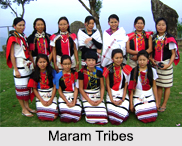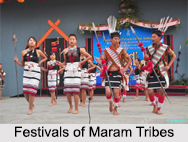 Maram Tribes are one of the sub-tribe of Naga tribes inhabiting at Senapati district of Manipur of northeast India. They are mainly found in Tabudi sub-division of Senapati district. It is the only tribe of Manipur which has been included in the list of primitive tribal groups of India.
Maram Tribes are one of the sub-tribe of Naga tribes inhabiting at Senapati district of Manipur of northeast India. They are mainly found in Tabudi sub-division of Senapati district. It is the only tribe of Manipur which has been included in the list of primitive tribal groups of India.
Origin of Maram Tribes
Maram Tribes are mainly scattered in various areas like Senapati district, Tadubi Sub-division and also Kangpokpi region. The origin of Maram tribes has a rich heritage behind it. In their cosmology, amongst three sons Karambungsa, the eldest brother Makikangba is considered to be ancestor of the Maram tribes. They are considered to be a part of Tibeto-Burman family of Mongoloid race. Linguistically, they belong to the sub-family of the Sino-Tibetan family.
Clans of Maram Tribes
The Maram tribe follows the ascending and descending genealogical lines through males only. Maram tribes have three localized descent groups - Lamkana, Magai-Bungnamei and Kagama. Each of the clans of Maram Tribes is an exogamous unit and has a number of sub-lineages. These major clans are Punglunamei, Rangnamei, Karangnamei, Naguina or Naguna, Bungnamei, Magaimei, Puinarnei, Najangmei or Nakijkoinamei or Majangmei and Kashammei or Kishumei.
Society of Maram Tribes
Among the Maram, the dormitory for the unmarried boys is called "Hangsaki" and "Kailiu" for the dormitory of the girls. The members learn their customs, folklore, folktales, dance, music, song and discipline from their seniors. Due to the influence of Christianity the role of youth dormitory is weakening gradually.
 Monogamy is the common form of marriage and polygamy is rare. They follow serial monogamy and straight monogamy. Tattoo painting is prevalent among the women.
Monogamy is the common form of marriage and polygamy is rare. They follow serial monogamy and straight monogamy. Tattoo painting is prevalent among the women.
Economic Life of Maram Tribes
Maram tribes are agriculturist and all agricultural activities are governed by their own customs. Shifting cultivation is the main cultivation practiced by them. They are also involved into wet cultivation. Paddy, maize, millet, bean, pumpkin, turmeric, ginger, chilli, cucumber, gourd, sweet potato, pulses and taro are grown through Jhum cultivation. Hunting is the secondary occupation of Maram tribes. They hunt whatever the animals or birds they get to see in the nearby forest. Basketry is the traditional occupation of Maram tribe.
Religious Life of Maram Tribes
Maram tribes are the worshippers of supernatural benevolent and malevolent beings. They offer worships by performing various rituals. These rituals satisfy various spirits and drive them away. They mainly worship "Pantheon". "Akrkot" is their house deity, while "Powmungba" is a wind deity. "Sara Kachinu", "Paranhaba" are some of the deities of Maram.
Festivals of Maram Tribes
Maram celebrate around 20 festivals a year. However Ponghi, Rakak and Kanghi are the main festivals. Invocation and glorification of gods is one of the main characteristic of the festivals of Maram tribes.
Dance and Music of Maram Tribes
The Maram tribes are very rich in dance, folksongs and traditional music. They perform dance and music in all socio-economic and religious occasions. Sarukatu dance is a war dance which is also very popular. Pahakatu is a traditional female dance which is performed by young girls. Pasuba is a dance performed by married girls. There are few other types of dances like the Bangkatu and Ngang katu which are performed in big festivals.
















